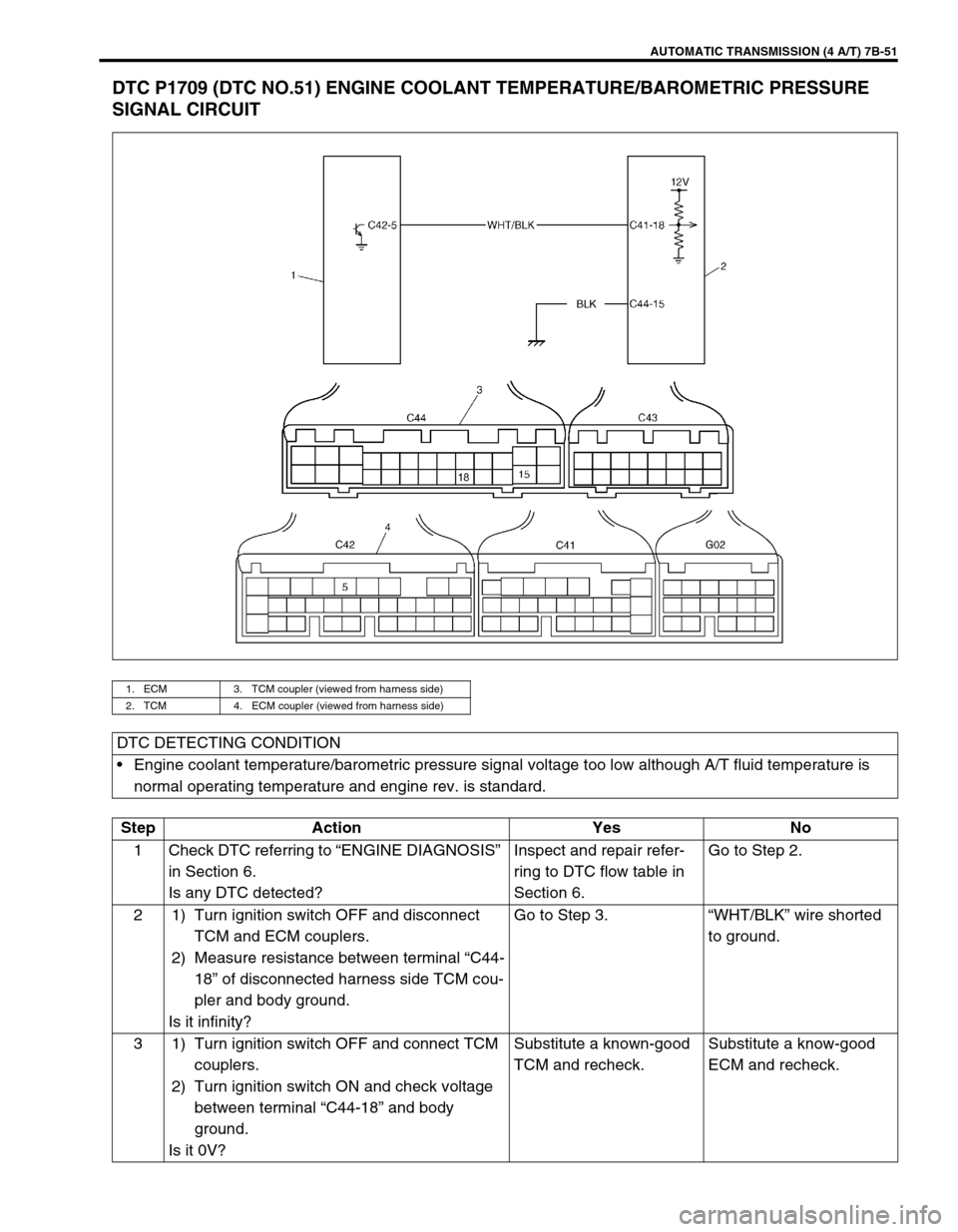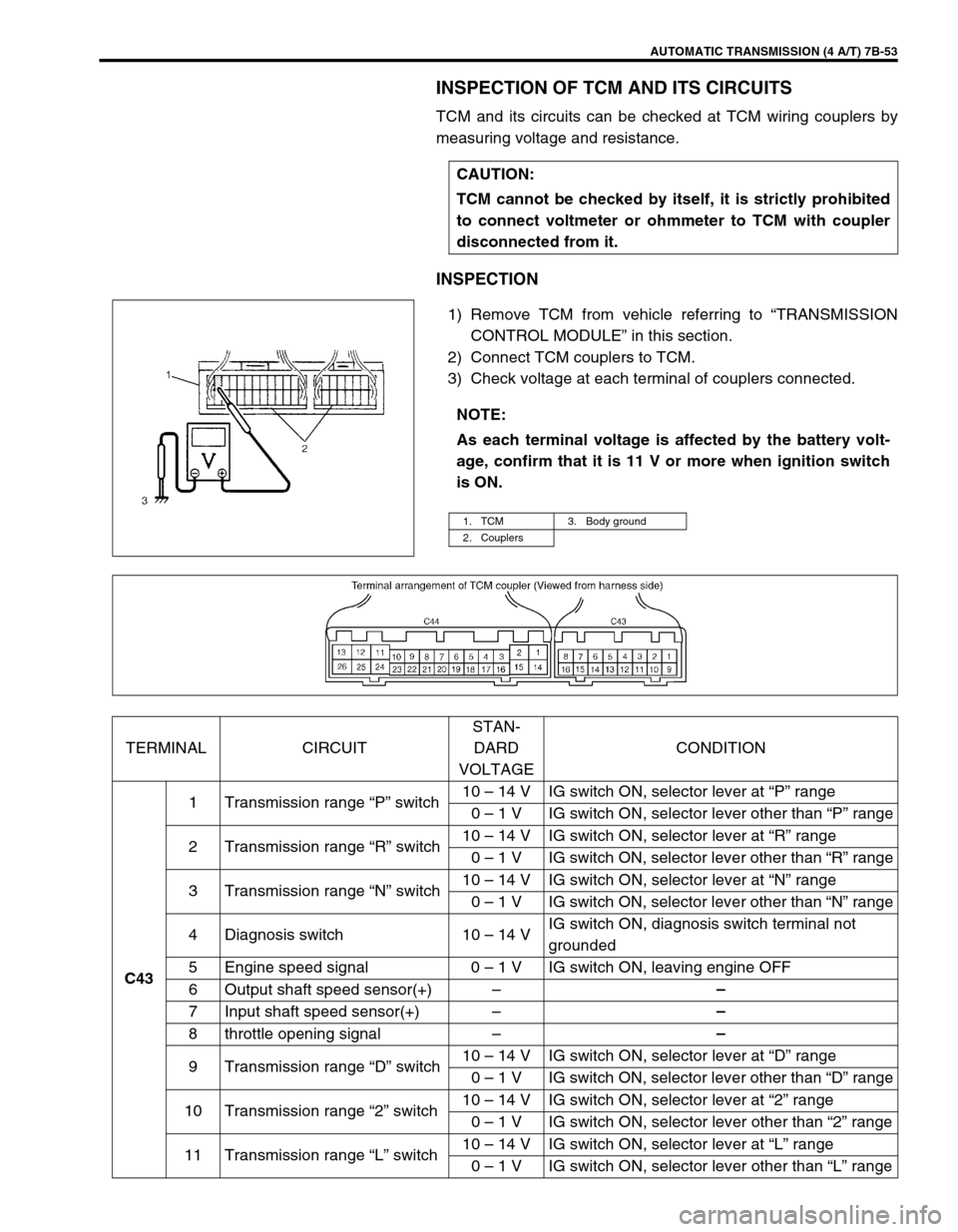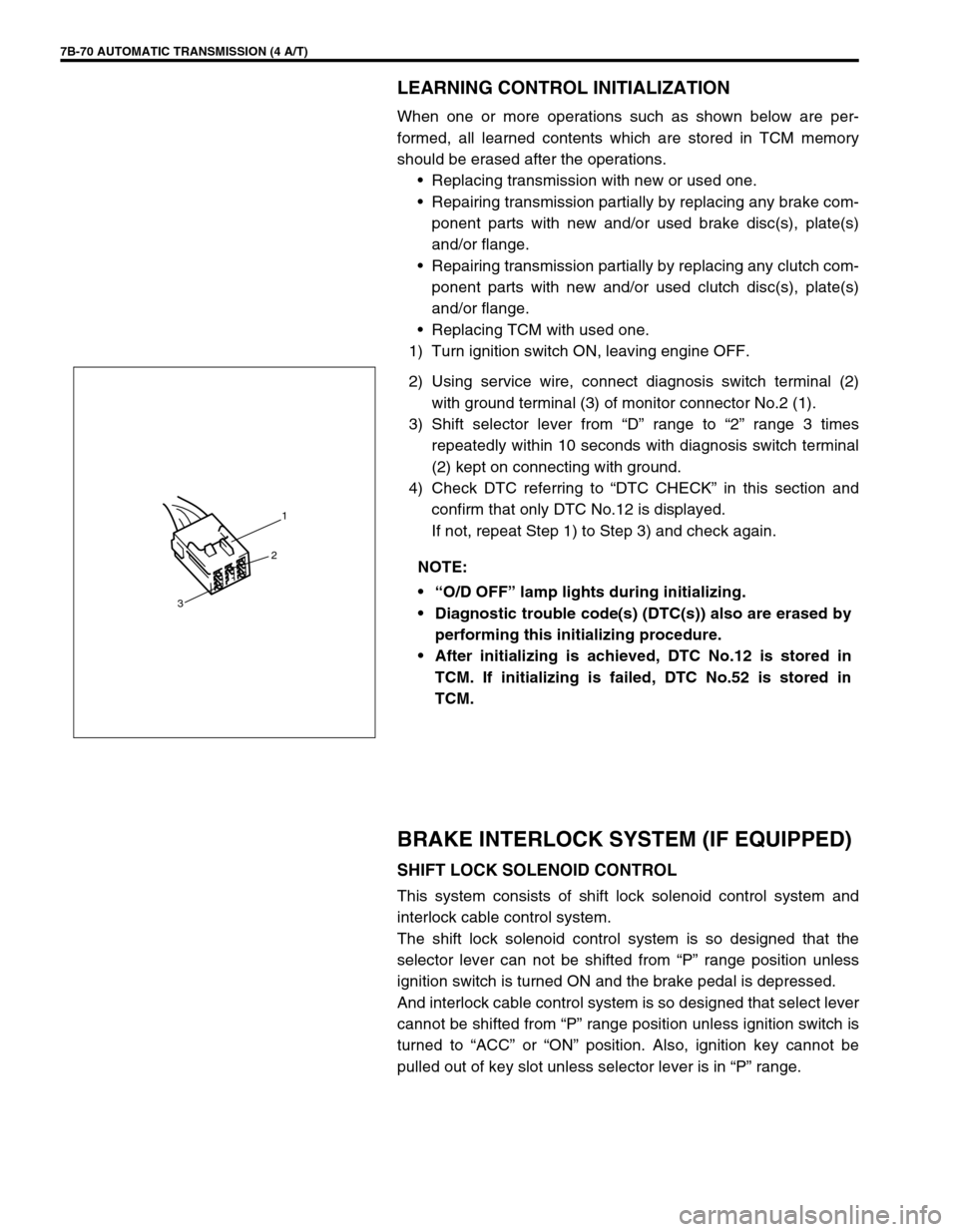Page 91 of 447

AUTOMATIC TRANSMISSION (4 A/T) 7B-49
DTC P0763 (DTC NO.43) SHIFT SOLENOID-C (NO.3) ELECTRICAL
DTC P0768 (DTC NO.45) SHIFT SOLENOID-B (NO.4) ELECTRICAL
DTC P0773 (DTC NO.48) SHIFT SOLENOID-E (NO.5) ELECTRICAL
1. Dropping resistor 4. Shift solenoid-D (No.4) 7. TCM coupler (viewed from harness side)
2. solenoid coupler 5. Shift solenoid-E (No.5)
3. Shift solenoid-C (No.3) 6. TCM
12V
C44-24
C44-13
C44-12
C44-11
C44-25
C44-26
C44-15
1
6
23
4
5
BRN/WHTGRY/BLU
RED/BLU
BLU/ORN
BRN
BLK/YEL
BRN/WHT
BLK/YEL
BRN
BLK
RED
YEL
BRN
7
DTC DETECTING CONDITION
Solenoid output voltage too high or too low differently from TCM order.
Step Action Yes No
1 1) Turn ignition switch OFF and disconnect sole-
noid coupler.
2) Measure resistance between terminal of sole-
noid coupler and transmission ground. (See
figure.)
Is it 2.5 – 3.5 Ω
?Go to Step 2.Solenoid lead wire open or
shorted to ground.
Malfunction of solenoid
valve.
2 1) Disconnect TCM couplers.
2) Measure resistance between terminal of dis-
connected body side solenoid coupler and
terminal “C44-11”, “C44-12” or “C44-13” of
disconnected harness side TCM coupler.
(See chart.)
Is it 6.5 – 8.5 Ω
?Go to Step 3. Inspect dropping resister refer-
ring to “DROPPING RESIS-
TOR” in this section.
If OK, circuit between TCM
and dropping resister or drop-
ping resister and solenoid cou-
pler open.
3 Check continuity between terminal “C44-24”,
“C44-25” or “C44-26” of disconnected TCM cou-
pler and terminal of disconnected body side sole-
noid coupler. (See chart.)
Is there continuity?Go to Step 4. Circuit between TCM and sole-
noid coupler open.
Page 93 of 447

AUTOMATIC TRANSMISSION (4 A/T) 7B-51
DTC P1709 (DTC NO.51) ENGINE COOLANT TEMPERATURE/BAROMETRIC PRESSURE
SIGNAL CIRCUIT
1. ECM 3. TCM coupler (viewed from harness side)
2. TCM 4. ECM coupler (viewed from harness side)
DTC DETECTING CONDITION
Engine coolant temperature/barometric pressure signal voltage too low although A/T fluid temperature is
normal operating temperature and engine rev. is standard.
Step Action Yes No
1 Check DTC referring to “ENGINE DIAGNOSIS”
in Section 6.
Is any DTC detected?Inspect and repair refer-
ring to DTC flow table in
Section 6.Go to Step 2.
2 1) Turn ignition switch OFF and disconnect
TCM and ECM couplers.
2) Measure resistance between terminal “C44-
18” of disconnected harness side TCM cou-
pler and body ground.
Is it infinity?Go to Step 3.“WHT/BLK” wire shorted
to ground.
3 1) Turn ignition switch OFF and connect TCM
couplers.
2) Turn ignition switch ON and check voltage
between terminal “C44-18” and body
ground.
Is it 0V?Substitute a known-good
TCM and recheck.Substitute a know-good
ECM and recheck.
Page 94 of 447
7B-52 AUTOMATIC TRANSMISSION (4 A/T)
DTC P0702/P1702 (DTC No.52)TRANSMISSION CONTROL SYSTEM ELECTRICAL OR
INTERNAL MALFUNCTION OF TCM
1. TCM 3. A/T relay
2. Ignition switch 4. TCM coupler (viewed from harness side)
DTC DETECTING CONDITION
Relay output voltage too high although TCM orders the relay to turn OFF or relay output voltage too low
although TCM orders the relay to turn on.
Incorrect calculations of checking TCM programmed data indicated.
Step Action Yes No
1 1) Turn ignition switch ON.
2) Erase all DTCs referring to “HOW TO
CLEAR DTC” in this section.
3) Turn ignition switch OFF.
4) Turn ignition switch ON once again and
check for any DTC.
Is it DTC P1702 (DTC No.52) or P0702 (DTC
No.52)?Replace TCM. Could be a temporary
malfunction of the TCM.
Page 95 of 447

AUTOMATIC TRANSMISSION (4 A/T) 7B-53
INSPECTION OF TCM AND ITS CIRCUITS
TCM and its circuits can be checked at TCM wiring couplers by
measuring voltage and resistance.
INSPECTION
1) Remove TCM from vehicle referring to “TRANSMISSION
CONTROL MODULE” in this section.
2) Connect TCM couplers to TCM.
3) Check voltage at each terminal of couplers connected.CAUTION:
TCM cannot be checked by itself, it is strictly prohibited
to connect voltmeter or ohmmeter to TCM with coupler
disconnected from it.
NOTE:
As each terminal voltage is affected by the battery volt-
age, confirm that it is 11 V or more when ignition switch
is ON.
1. TCM 3. Body ground
2. Couplers
TERMINAL CIRCUITSTAN-
DARD
VOLTAGECONDITION
C431 Transmission range “P” switch10 – 14 V IG switch ON, selector lever at “P” range
0 – 1 V IG switch ON, selector lever other than “P” range
2 Transmission range “R” switch10 – 14 V IG switch ON, selector lever at “R” range
0 – 1 V IG switch ON, selector lever other than “R” range
3 Transmission range “N” switch10 – 14 V IG switch ON, selector lever at “N” range
0 – 1 V IG switch ON, selector lever other than “N” range
4 Diagnosis switch 10 – 14 VIG switch ON, diagnosis switch terminal not
grounded
5 Engine speed signal 0 – 1 V IG switch ON, leaving engine OFF
6 Output shaft speed sensor(+)––
7 Input shaft speed sensor(+)––
8 throttle opening signal––
9 Transmission range “D” switch10 – 14 V IG switch ON, selector lever at “D” range
0 – 1 V IG switch ON, selector lever other than “D” range
10 Transmission range “2” switch10 – 14 V IG switch ON, selector lever at “2” range
0 – 1 V IG switch ON, selector lever other than “2” range
11 Transmission range “L” switch10 – 14 V IG switch ON, selector lever at “L” range
0 – 1 V IG switch ON, selector lever other than “L” range
Page 112 of 447

7B-70 AUTOMATIC TRANSMISSION (4 A/T)
LEARNING CONTROL INITIALIZATION
When one or more operations such as shown below are per-
formed, all learned contents which are stored in TCM memory
should be erased after the operations.
Replacing transmission with new or used one.
Repairing transmission partially by replacing any brake com-
ponent parts with new and/or used brake disc(s), plate(s)
and/or flange.
Repairing transmission partially by replacing any clutch com-
ponent parts with new and/or used clutch disc(s), plate(s)
and/or flange.
Replacing TCM with used one.
1) Turn ignition switch ON, leaving engine OFF.
2) Using service wire, connect diagnosis switch terminal (2)
with ground terminal (3) of monitor connector No.2 (1).
3) Shift selector lever from “D” range to “2” range 3 times
repeatedly within 10 seconds with diagnosis switch terminal
(2) kept on connecting with ground.
4) Check DTC referring to “DTC CHECK” in this section and
confirm that only DTC No.12 is displayed.
If not, repeat Step 1) to Step 3) and check again.
BRAKE INTERLOCK SYSTEM (IF EQUIPPED)
SHIFT LOCK SOLENOID CONTROL
This system consists of shift lock solenoid control system and
interlock cable control system.
The shift lock solenoid control system is so designed that the
selector lever can not be shifted from “P” range position unless
ignition switch is turned ON and the brake pedal is depressed.
And interlock cable control system is so designed that select lever
cannot be shifted from “P” range position unless ignition switch is
turned to “ACC” or “ON” position. Also, ignition key cannot be
pulled out of key slot unless selector lever is in “P” range. NOTE:
“O/D OFF” lamp lights during initializing.
Diagnostic trouble code(s) (DTC(s)) also are erased by
performing this initializing procedure.
After initializing is achieved, DTC No.12 is stored in
TCM. If initializing is failed, DTC No.52 is stored in
TCM.
1
2
3
Page 113 of 447

AUTOMATIC TRANSMISSION (4 A/T) 7B-71
SHIFT LOCK SOLENOID MANUAL RLEASE
Without using brake pedal, shift lock can be moved by pushing
shift lock solenoid cam (1) with screw driver or like through hole
(2). (To shift selector lever from “P” range to any other position,
turn ignition switch to “ACC” or “ON” position.)
INSPECTION
1) Check to make sure that selector lever cannot be moved to
any other range from “P” range position when ignition switch
key is at “ACC” position, at “LOCK” position (or it is removed
from keyhole of ignition switch) or brake pedal is not
depressed.
2) Shift selector lever to “P” range position, release knob button
and check for the following.
Ignition key can be turned between “LOCK” and “ACC” posi-
tions back and forth and also it can be removed from ignition
switch.
With shift lock solenoid cam (1) moved in arrow direction and
ignition key turned to “ACC” position, selector lever can be
shifted from “P” range position to any other range.
With shift lock solenoid cam moved in arrow direction and
ignition key turned to “LOCK” position, selector lever can not
be shifted from “P” range position to any other range.
1
2
1
Page 114 of 447
7B-72 AUTOMATIC TRANSMISSION (4 A/T)
When ignition switch is turned “ON” and brake pedal is
depressed, selector lever can be shifted from “P” range posi-
tion to any other range.
3) With ignition lever shifted to any position other than “P”
range, check that ignition key cannot be turned “LOCK” posi-
tion and it cannot be removed from ignition switch unless it is
at “LOCK” position.
KEY INTERLOCK CABLE (IF EQUIPPED)
1. selector lever 3. key inter lock cable
2. knob button 4. key cylinder
NOTE:
Don’t bend interlock cable excessively when removing and installing it, or system will not operate
correctly.
Page 115 of 447
AUTOMATIC TRANSMISSION (4 A/T) 7B-73
REMOVAL
1) Disconnect negative cable at battery and disable air bag sys-
tem, referring to “DISABLING AIR BAG SYSTEMS” in Sec-
tion 10B (if equipped).
2) Remove steering column hole cover and steering column
cover.
3) Remove steering column mounting bolts and nuts.
4) Remove interlock cable screw (1) located at ignition switch
and disconnect interlock cable (2) from key cylinder arm (3)
with ignition switch turned to “ACC” position.
5) Remove center console.
6) Remove cable end (1) from key interlock cam (2) and its
bracket (3).
7) Remove interlock cable (4).
INSTALLATION
1) Install interlock cable (1) to pedal brackets (2) by clamp as
shown in figure.
2) With ignition key at “ACC” position, connect cable end (1) to
key cylinder arm (2) and tighten cable screw (3) securely.